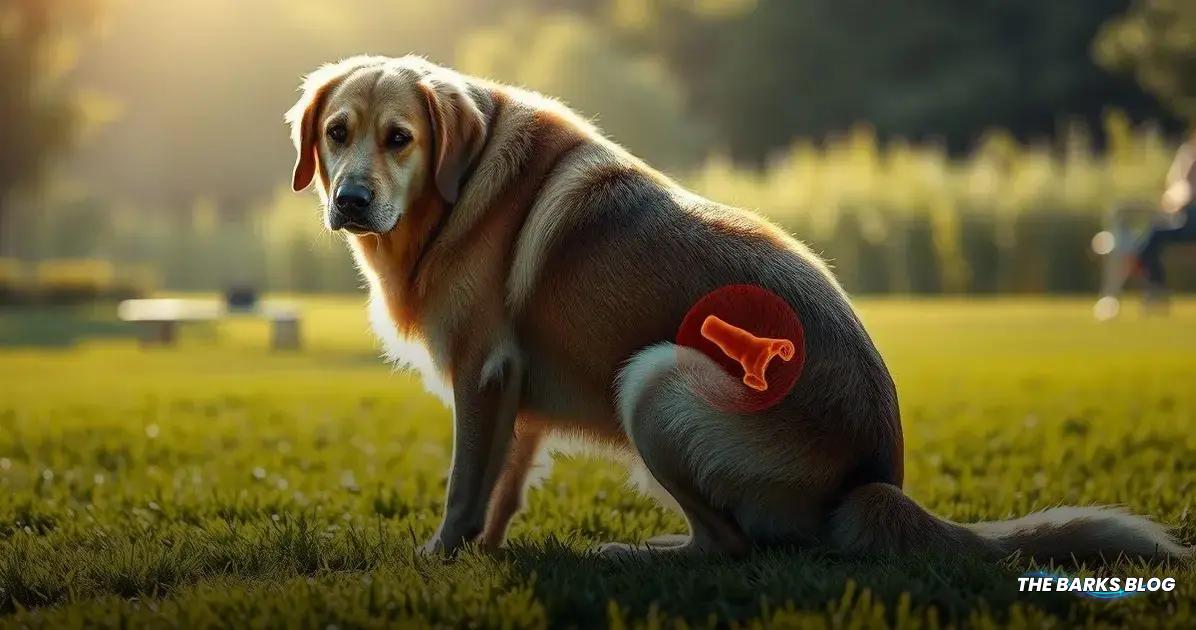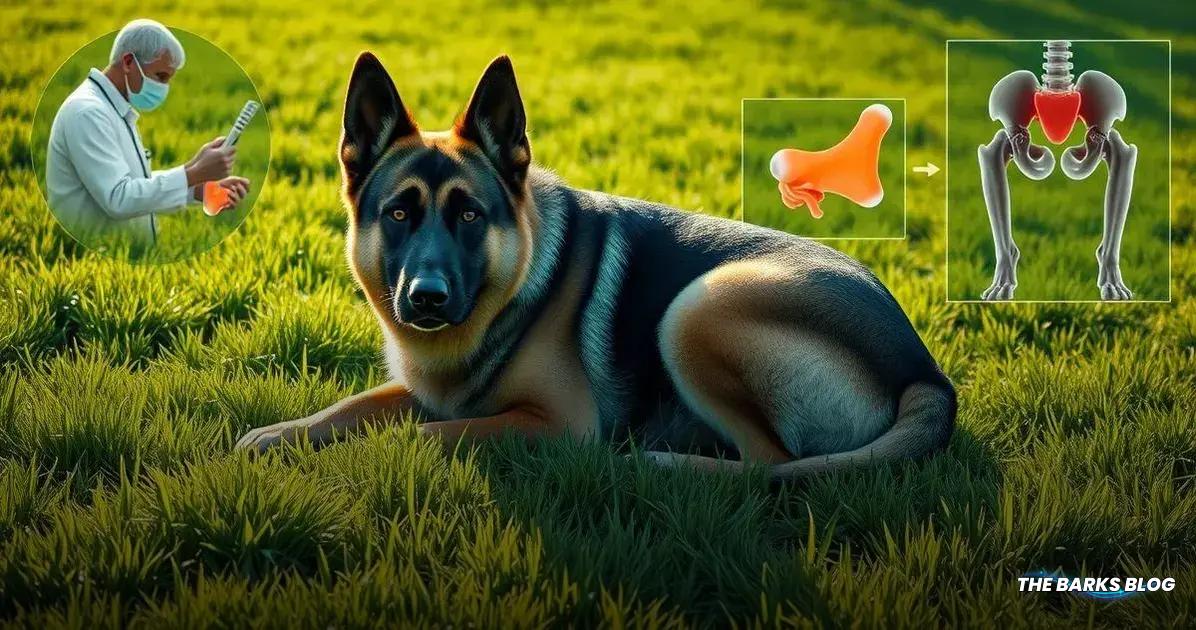Hip dysplasia is a prevalent condition in dogs, especially in large breeds, characterized by a mismatch in growth between the hip joint’s ball and socket, resulting in pain and mobility issues. Common symptoms include lameness and difficulty moving, typically seen in dogs aged 1-2 years. Diagnosis is made through physical exams and X-rays, with treatment options ranging from medication and physical therapy to surgical procedures like total hip replacement. Preventive strategies involve responsible breeding and weight management, allowing many affected dogs to maintain an active lifestyle with proper care.
Hip dysplasia in dogs is a common condition that affects large breeds, where the hip joint does not develop properly, leading to pain and mobility issues.

What is Hip Dysplasia?
Hip dysplasia is a developmental condition that primarily affects large-breed puppies during their growth phase. It occurs when the components of the hip joint, specifically the femoral head (the ball) and the acetabulum (the socket), do not grow at the same rate. This mismatch leads to increased laxity or looseness within the hip joint, which can cause significant issues as the dog matures.
In a normal dog, the femoral head fits snugly into the acetabulum, allowing for smooth movement and stability. However, in dogs with hip dysplasia, the socket is often shallow or flattened, and the ball may be irregularly shaped, resulting in instability and abnormal wear of the joint surfaces.
This condition can lead to joint dysfunction, the development of arthritis, pain, and decreased mobility, affecting the dog’s quality of life. While hip dysplasia is primarily inherited, factors such as nutrition, obesity, and environment can also influence its development. Recognizing the signs early and seeking veterinary advice can help manage the condition effectively.

Symptoms and Diagnosis
Symptoms of hip dysplasia can manifest as early as 3-4 months of age, but many dogs do not show noticeable signs until they are 1-2 years old. The severity of symptoms can vary widely depending on the degree of joint laxity and the presence of arthritis. Common symptoms include:
Stiffness or limping in the hind limbs
A swaying or “bunny hopping” gait when moving
Lameness without any prior injury or trauma
Difficulty rising, jumping on or off furniture, or climbing stairs
Abnormal sitting positions
Difficulty standing for extended periods
Loss of muscle mass in the thighs
Visible pain when the hip joints are touched or manipulated
Decreased range of motion in the hind limbs
Unusual calmness or lethargy in puppies
To diagnose hip dysplasia, veterinarians typically perform a comprehensive physical examination followed by diagnostic imaging, such as X-rays. During the physical exam, the vet will look for an abnormal gait, particularly noting any swaying or hopping movements.
One specific technique used in young dogs is the Ortolani Palpation Method, which assesses hip laxity by attempting to displace the femur and listening for a characteristic “clunk” when the femur returns to the socket. This method often requires sedation for accuracy.
X-rays are the primary diagnostic tool for confirming hip dysplasia and determining its severity. The images help visualize the hip joint’s structure and any signs of degenerative joint disease. Proper positioning and sedation are crucial to obtaining clear and accurate X-ray results.

The Stages and Severity of Hip Dysplasia
The severity of hip dysplasia can vary significantly among dogs, influenced by factors such as genetics, age, weight, and overall health. Understanding the stages and severity of this condition is crucial for effective management and treatment.
Hip dysplasia is often categorized into different stages based on the degree of joint laxity and the presence of arthritis:
- Mild Dysplasia: In this stage, the hip joint may show slight laxity, but the dog might exhibit minimal to no symptoms. X-rays may reveal minor abnormalities, and many dogs can lead normal lives with proper management.
- Moderate Dysplasia: Dogs in this stage may begin to show noticeable symptoms such as stiffness, lameness, or difficulty with physical activities. X-rays will likely show more pronounced joint laxity and early signs of arthritis. Treatment may involve lifestyle changes and medication to manage pain and inflammation.
- Severe Dysplasia: In severe cases, the hip joint is significantly loose, leading to chronic pain and mobility issues. Dogs may struggle to perform basic activities like walking or climbing stairs. X-rays will typically reveal advanced joint changes and significant arthritis. Surgical intervention may be necessary to alleviate pain and improve quality of life.
It’s important to note that some dogs may have severe radiographic findings but display minimal clinical symptoms, while others with mild X-ray findings can exhibit significant discomfort. Factors such as body weight and muscle mass play a role in how well a dog tolerates the condition. Heavier dogs may experience more stress on their joints, exacerbating the symptoms.
As hip dysplasia progresses, the laxity in the joint can lead to further joint damage, including abnormal bone formation and increased inflammation, which can significantly impact the dog’s mobility and overall quality of life. Early diagnosis and intervention are key to managing this condition effectively.

Treatment Options
Treatment options for hip dysplasia depend on the severity of the condition and the individual dog’s symptoms. The goal is to manage pain, improve mobility, and enhance the dog’s quality of life. Treatment can be categorized into non-surgical and surgical options.
Non-Surgical Treatments
- Medications: Non-steroidal anti-inflammatory drugs (NSAIDs) are commonly prescribed to help reduce pain and inflammation. Other pain medications, such as gabapentin, tramadol, and amantadine, may also be used in conjunction with NSAIDs. Regular bloodwork is recommended to monitor for potential side effects from long-term medication use.
- Joint Supplements: Supplements containing glucosamine and chondroitin sulfate can support joint health and slow the progression of arthritis. These should be given consistently for optimal results.
- Weight Management: Maintaining a healthy weight is crucial for dogs with hip dysplasia. Losing excess weight can significantly reduce stress on the joints, alleviating pain and improving mobility. A balanced diet and regular, low-impact exercise are essential components of weight management.
- Physical Therapy: Techniques such as underwater treadmill exercises, stretching, and strengthening routines can help improve joint function and reduce discomfort. Integrative therapies like acupuncture, cold laser therapy, and massage may also provide relief.
Surgical Treatments
If non-surgical options are insufficient, surgical interventions may be necessary, especially in severe cases:
- Total Hip Replacement (THR): This procedure involves replacing the entire hip joint with artificial components made of metal and plastic. THR is often recommended for large or giant-breed dogs with severe hip dysplasia that do not respond to conservative management. While it can significantly improve joint function and reduce pain, it is also the most expensive surgical option.
- Femoral Head/Neck Ostectomy (FHNO): This surgery removes the femoral head, allowing the body to form a “false” joint using scar tissue. This option is particularly suitable for small and medium-breed dogs and can be performed in both young and adult dogs. Although it does not restore normal hip function, it can effectively alleviate pain.
- Juvenile Pubic Symphysiodesis (JPS) and Triple Pelvic Osteotomy (TPO): These procedures are typically performed on puppies and aim to preserve hip joint anatomy and reduce the risk of arthritis later in life. They involve altering the pelvic bones to improve the fit of the femoral head in the acetabulum. These surgeries are less invasive and less expensive than THR but are only suitable for specific cases.
Ultimately, the choice of treatment will depend on the individual dog’s age, weight, severity of the condition, and response to initial management strategies. A veterinarian will work closely with pet owners to develop a tailored treatment plan that best meets the needs of the dog.

Living with Hip Dysplasia
Living with hip dysplasia can be challenging for both dogs and their owners, but there are several strategies that can help improve a dog’s comfort and quality of life. Managing this condition requires a proactive approach to ensure that dogs can still enjoy their daily activities while minimizing pain and discomfort.
Weight Management
Maintaining a healthy weight is crucial for dogs with hip dysplasia. Excess weight places additional stress on the joints, exacerbating pain and limiting mobility. Pet owners should work with their veterinarian to establish a balanced diet and portion control to help their dog achieve and maintain an ideal weight.
Daily Exercise
While exercise is important, the intensity and type of activity should be carefully managed. Daily, low-impact exercises such as leash walking or swimming are excellent options for dogs with hip dysplasia. These activities help maintain muscle mass and joint mobility without putting excessive strain on the hips.
Avoiding High-Impact Activities
Owners should avoid allowing their dogs to engage in high-impact activities, such as jumping or running on hard surfaces, as these can worsen symptoms. If stairs are unavoidable, consider using ramps to help your dog navigate without putting too much pressure on their hips.
Comfortable Resting Areas
Providing a soft, supportive place for your dog to rest is essential. An orthopedic pet bed can help alleviate pressure on the joints and improve overall comfort. Additionally, ensuring that frequently used areas are free of clutter and have non-slip surfaces can help prevent slips and falls.
Warmth and Comfort
Keeping your dog warm during colder months can also help reduce discomfort associated with arthritis. Consider using blankets or heated pet beds to provide extra warmth and comfort.
Regular Veterinary Check-Ups
Regular veterinary check-ups are essential for monitoring the condition and adjusting treatment plans as necessary. Your veterinarian can provide guidance on managing pain, adjusting medications, and suggesting additional therapies that may benefit your dog.
Supportive Equipment
Consider using supportive equipment, such as harnesses or slings, to assist your dog with mobility. These tools can help reduce strain on the hips and make it easier for your dog to get around.
By implementing these strategies and working closely with a veterinarian, pet owners can help their dogs with hip dysplasia live a more comfortable and fulfilling life. Early intervention and ongoing management are key to ensuring that dogs can continue to enjoy their favorite activities while minimizing pain and discomfort.

Prevention and Breeding Considerations
While hip dysplasia is largely a hereditary condition, there are several preventive measures that pet owners and breeders can take to reduce the risk of its development in dogs. Understanding these strategies is vital for prospective dog owners, especially those considering large or giant-breed puppies.
Preventive Strategies for Pet Owners
- Nutrition: Feeding a balanced diet appropriate for the dog’s age and breed is crucial. Avoid free-feeding large-breed puppies, as rapid growth can lead to skeletal issues. Consult your veterinarian for dietary recommendations tailored to your puppy’s needs.
- Exercise: Providing appropriate levels of exercise helps maintain a healthy weight and supports joint health. Avoid high-impact activities, especially during the early growth stages, to prevent undue stress on developing joints.
- Joint Supplements: For high-risk breeds, consider starting joint supplements containing glucosamine and chondroitin as early as three months of age. These supplements can support joint health and potentially mitigate the risk of developing hip dysplasia.
Breeding Considerations
Responsible breeding practices play a critical role in preventing inherited hip dysplasia:
- Screening Breeding Dogs: Breeders should conduct hip evaluations using recognized screening methods, such as the Orthopedic Foundation for Animals (OFA) technique or the PennHIP procedure, before breeding. These assessments help identify dogs with hip dysplasia or those predisposed to the condition.
- OFA Technique: This method involves taking X-rays of the hips at 24 months of age or older while under sedation or anesthesia. The resulting images are evaluated by certified radiologists, and dogs with favorable scores are registered as OFA-certified.
- PennHIP Procedure: Conducted on puppies as young as 16 weeks, the PennHIP method assesses hip laxity by taking two different X-ray views. This technique provides a distraction index measurement, indicating the likelihood of developing hip dysplasia in the future.
While responsible breeding and preventive measures cannot guarantee that a dog will be free from hip dysplasia, they can significantly reduce the risk. Prospective dog owners should thoroughly research their chosen breed and select reputable breeders who prioritize health testing and responsible breeding practices.

Key Facts about Hip Dysplasia
Here are some key facts about hip dysplasia in dogs that every pet owner should know:
Definition: Hip dysplasia is a developmental disease of the hip joint, where the components of the hip (the ball and socket) do not grow at the same rate, leading to looseness and instability.
Common in Large Breeds: While hip dysplasia is more prevalent in large-breed dogs, it can also affect smaller breeds and even cats.
Genetic Factors: Genetics play a significant role in the development of hip dysplasia. It is often inherited, so understanding the lineage of a puppy can provide insights into potential risks.
Symptoms: Symptoms may include lameness, difficulty jumping or climbing stairs, abnormal gaits, and a decrease in activity level. Many dogs do not show symptoms until they are older, typically between 1-2 years of age.
Diagnosis: Diagnosis typically involves a physical examination and diagnostic imaging, such as X-rays, to assess the hip joint’s condition and severity of dysplasia.
Treatment Options: Treatment can range from non-surgical options, such as medications and physical therapy, to surgical interventions like total hip replacement, depending on the severity of the condition.
Management: Living with hip dysplasia requires ongoing management, including weight control, low-impact exercise, and comfort measures to help alleviate pain and improve mobility.
Prevention: Responsible breeding practices, appropriate nutrition, and early intervention can help reduce the risk of developing hip dysplasia in dogs.
Prognosis: With proper management and treatment, many dogs with hip dysplasia can lead a normal, active life, although adjustments may be necessary to accommodate their condition.
Understanding these key facts can help pet owners better manage the health and well-being of their dogs, especially those at risk of hip dysplasia.

Common Risk Factors
Several risk factors can contribute to the development of hip dysplasia in dogs. Understanding these factors is essential for pet owners, particularly those considering large or giant-breed puppies. Here are some common risk factors associated with hip dysplasia:
Genetics: Hip dysplasia is often hereditary, meaning that dogs with a family history of the condition are more likely to develop it themselves. Responsible breeding practices can help reduce the incidence of genetic predisposition.
Nutrition: Poor nutrition during a dog’s growth phase can lead to rapid and abnormal growth of muscles, bones, and joints. Free-feeding large-breed puppies can result in excessive weight gain and increase the risk of developing hip dysplasia.
Obesity: Maintaining a healthy weight is crucial for dogs, as excess weight puts additional stress on the joints. Obesity can exacerbate the symptoms of hip dysplasia and increase the likelihood of developing arthritis.
Exercise: Inappropriate exercise during the critical growth period can contribute to hip dysplasia. For example, allowing puppies to run up and down stairs or engage in high-impact activities before their joints are fully developed can increase the risk.
Neutering Age: Although somewhat controversial, studies suggest that early neutering (before 5.5 months of age) may be linked to a higher incidence of hip dysplasia in certain breeds.
Breed Predisposition: Certain breeds are more prone to hip dysplasia, including German Shepherds, Labrador Retrievers, Golden Retrievers, Great Danes, and Saint Bernards. Understanding breed-specific risks can help owners make informed decisions about their pets.
Environmental Factors: Factors such as the dog’s living environment and activity level can also influence the development of hip dysplasia. Puppies raised in areas with ample space for exercise may have a lower risk compared to those confined in small spaces.
By being aware of these common risk factors, pet owners can take proactive steps to minimize the chances of their dogs developing hip dysplasia and ensure a healthier, happier life for their furry companions.

Conclusion and Final Thoughts
In conclusion, hip dysplasia is a common developmental condition primarily affecting large and giant-breed dogs. It results from a combination of genetic factors and environmental influences, leading to abnormal growth of the hip joint and subsequent joint instability.
Recognizing the symptoms early and understanding the various stages of severity can significantly impact the management and treatment options available for affected dogs.
While there is no guaranteed way to prevent hip dysplasia, responsible breeding practices, proper nutrition, and weight management can help reduce the risk. Pet owners should be proactive in monitoring their dogs for any signs of discomfort or mobility issues and seek veterinary advice when necessary.
With appropriate treatment—whether through medication, physical therapy, or surgical intervention—many dogs with hip dysplasia can lead happy, active lives. Early diagnosis and a tailored management plan are key to ensuring that dogs can continue to enjoy their favorite activities while minimizing pain and discomfort.
Ultimately, understanding hip dysplasia and its implications empowers pet owners to make informed decisions regarding their dog’s health and well-being. By prioritizing responsible care and regular veterinary check-ups, pet owners can help their furry companions thrive despite the challenges posed by this condition.
Conclusion
Hip dysplasia is a significant concern for many dog owners, particularly for those with large and giant breeds.
This developmental condition can lead to pain, discomfort, and mobility issues if not properly managed.
However, with early diagnosis and a comprehensive treatment plan, including lifestyle adjustments, medication, and possibly surgery, many dogs can continue to lead happy and fulfilling lives.
By understanding the risk factors, symptoms, and available treatment options, pet owners can take proactive steps to support their dogs’ health.
Regular veterinary check-ups and responsible breeding practices are essential in mitigating the risks associated with hip dysplasia.
Ultimately, while hip dysplasia poses challenges, informed and attentive care can significantly enhance the quality of life for affected dogs, allowing them to enjoy their time with their families.
FAQ – Frequently Asked Questions about Hip Dysplasia in Dogs
What is hip dysplasia in dogs?
Hip dysplasia is a developmental disease in dogs, especially large breeds, where the hip joint’s ball and socket do not grow at the same rate, leading to looseness and instability.
What causes hip dysplasia?
Hip dysplasia is primarily caused by genetic factors, but other influences such as nutrition, obesity, exercise, environment, neutering age, and breed predisposition can also increase the risk.
What are the common symptoms of hip dysplasia?
Common symptoms include lameness, difficulty jumping or climbing stairs, abnormal gaits, stiffness, loss of thigh muscle mass, and unusual calmness in puppies.
How is hip dysplasia diagnosed?
Diagnosis typically involves a physical examination and diagnostic imaging, such as X-rays, to assess the hip joint’s condition and severity of dysplasia.
What treatment options are available for hip dysplasia?
Treatment options can be non-surgical, such as medications and physical therapy, or surgical interventions like total hip replacement, depending on the severity of the condition.
Can hip dysplasia be prevented?
While it cannot be entirely prevented, responsible breeding practices, proper nutrition, and maintaining a healthy weight can help reduce the risk of hip dysplasia in dogs.
Can dogs with hip dysplasia live a normal life?
Yes, with early diagnosis and appropriate treatment, many dogs with hip dysplasia can lead a normal and healthy life, although adjustments may be needed to manage pain and mobility.




